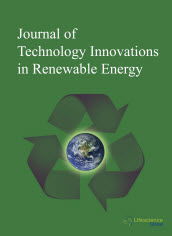jtire
|
|
|
Abstract: A numerical mathematical model has been developed to predict the thermal behavior of phase change material during thermal storage. The model includes the effects of various mechanisms of heat transfer such as conduction, convection as well as fusion of the phase change material. Water/Ice was used as a phase change material. The thermal behavior of the phase change material during cooling has been studied experimentally and analyzed under different conditions. Comparisons were made against experimental data for validation of the predictive model. The model fairly predicted experimental data obtained at various inlet conditions. Keywords: Phase change material, thermal storage, numerical model, simulation.Download Full Article |
|
|
|
Abstract: The paper presents a simulation study using the numerical simulator SCAPS-1D to model ZnO/Cd0.8Zn0.2S/CuIn(1-y)GaySe2/CuInSe2 structures. Effects of thickness of graded and ungraded CIGS absorbers and buffer layers on cell performance have been investigated with the aim to reach a higher efficiency. Quantum efficiency (QE) as function of wavelength and thickness of these layers was studied. The high efficiency of CIGS cells, in order of 22.05%, has reached with the absorbers thickness between 2μm and 3.5μm and with acceptor concentration of about 2.1016 cm3. Other hand, we investigate the effect of Cd0.8Zn0.2S ternary compound buffer on the top of the p-CIGS cell. These simulation results give some important indication to enable further development of multilayer thin-film solar cells based on CuInGaSe2 with Cd0.8Zn0.2S as buffer layer instead of CdS. Keywords: Photovoltaic parameters, CIGS solar cells, CdZnS, SCAPS-1D, Modeling.Download Full Article |
|
|
|
Abstract: This paper presents a thirty year (1976-2005) assessment of wave energy resource within the South China Sea (SCS) by simulation. Significant wave height (SWH) between simulation and observation shows good agreement. This shows the reliability of an along-side simulated wave period in estimating wave energy in the SCS. Results show that estimates of wave power density are more reliable in the north-central SCS and most sufficient during winter. The annual mean wave power density peaked at 12.7kW/m and 12.9kW/m during years 1986 and 1999 respectively while the highest seasonal mean of 29kW/m occurred in year 1999 during winter. The wave power density is most stable in winter and is generally more stable in offshore regions of SCS. Wave power density is most stable in years 1976, 1997 and 2004 with stability values of 1.96, 1.98 and 1.9 respectively. The stability value of 0.9 in year 1980 is the greatest in the winter of all years. Relative-rich energy regions occupy the largest area during winter. The relatively richest energy is generally concentrated in the central and north-central SCS. No area is identified as a relative-rich energy region during spring. Winter 1999 has the highest relative-rich energy with value of 37kW/m. Keywords: South China Sea, Wave power density, Wave power stability, Relative-rich energy, Distribution.Download Full Article |
|
|
|
Abstract: Nigeria is one of the world’s leading producers of crude oil and yet it is a net importer of refined oil. Its average daily premium motor spirit (PMS) consumption is 30 million liters. At 100% capacity the nation’s refineries will produce 17.74 million liters of premium motor spirit daily. A shortfall of over 10 million liters per day exists. Recent estimates stipulate that Nigeria requires 20,000 MW of electricity per annum. The projected electricity supply from all sources (conventional and renewable) in Nigeria in the short (2007), medium (2015) and long term (2025) is estimated to be 7000 MW, 14000 MW and 29,000 MW respectively. Annual peak electricity demand in Nigeria will increase from 4,558 MW to 45,755 MW in 2050 at high growth rate and 4,558 to 19,599 MW for low growth. Nigeria’s electricity per capita of 27 W/person is not enough to light an electric incandescent bulb of 30 W. These provide enough justification for the use of renewable energy in Nigeria. The use of renewable energy in Nigeria is hindered by the lack of regulation, financial incentives, energy infrastructures, framework for sustainability and technical expertise. Overcoming these obstacles will require invigorating research and development in renewable energy technologies, training and education to build local technical capacity, diversification of energy mix and scaling up of renewable energy utilization, aggressive capacity building in all areas of energy development and creation of enabling environment that will attract investment in energy infrastructure. This paper discusses the obstacles and way forward in promoting renewable energy in Nigeria. Keywords: Obstacle, way forward, promotion, renewable energy, Nigeria.Download Full Article |
|
|
|
Abstract: This research work reports on the optical and photovoltaic performance of dihexyl-sexithiophene (DH6T) doped with various molar percentages of tris-8-hydroxyquinolinate aluminium (Alq3) dissolved in chloroform/hexane co-solvent. Films of DH6T(1-x)Alq3(x) composite have been produced by casting technique aiming at investigating their absorption edge energies (Eabs) and hence identifying the optimum content of Alq3. It was found that by introducing a controlled amount of Alq3, the value of Eabs can be tuned from 2.69 eV to 1.76 eV. An empirical equation was derived to fit the obtained experimental data, by which an optimum Eabs at molar concentration of (x ≈ 25%) was predicted. Finally, organic solar cells based on the optimum active layer content were fabricated and tested. Comparably, it was observed that the photovoltaic performance of the DH6T:Alq3 based devices is much better than that achieved for the DH6T:PCBM based ones. Efficiency and fill factor for the devices based on DH6T(0.75)Alq3(0.25) active layer were found to be 0.22% and 26.5%, respectively, while those for DH6T:PCBM based devices were about 0.01% and 24%, respectively. Keywords: Alq3, DH6T, Organic composite, Doping, Absorption edge, organic solar cells.Download Full Article |


